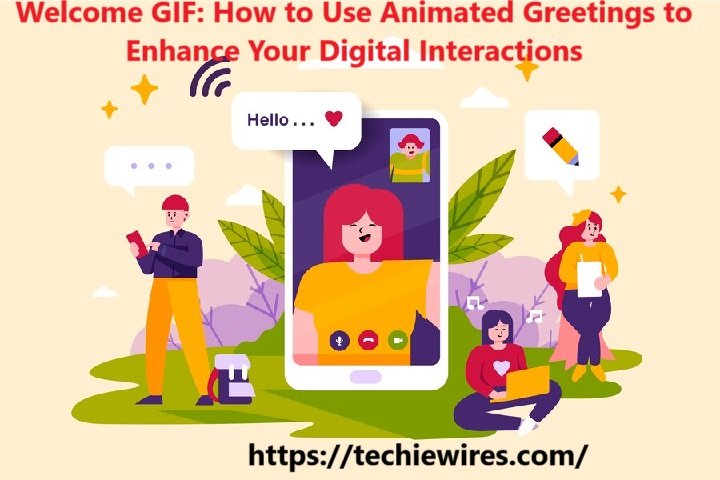Welcome GIF: How to Use Animated Greetings to Enhance Your Digital Interactions
In the digital world, first impressions matter more than ever. Whether you’re greeting a new subscriber, welcoming a new customer, or engaging with users on social media, a simple yet effective way to make that first connection is through a welcome GIF. Animated graphics have become a powerful tool in modern communication, offering a fun, dynamic, and visually engaging way to say “hello.”
In this article, we’ll explore what welcome GIFs are, why they are so effective, how to create them, and the best practices for using them in different digital spaces like websites, emails, and social media.
What is a Welcome GIF?
A welcome GIF is a short, looping animation designed to greet or welcome users. It can be a text-based GIF with the word “welcome” creatively displayed, or an image of a person or character greeting someone. Welcome GIFs can be simple and straightforward or more elaborate and entertaining.
Why Use Welcome GIFs?
Here’s why welcome GIFs can be a game-changer for your digital interactions:
- Visual Appeal: GIFs are a visual medium that grabs attention faster than static images or text. They are fun, vibrant, and instantly engaging.
- Emotional Connection: A well-designed GIF can convey warmth, excitement, or friendliness, helping to build an emotional connection with the audience.
- Increased Engagement: Social media platforms and websites that use GIFs tend to experience higher engagement rates. GIFs stand out in feeds, emails, or chat interactions, encouraging viewers to stop and pay attention.
- Better Communication: Sometimes, words alone aren’t enough to convey a warm welcome. An animated GIF can capture the mood and tone you want to project more effectively.
- Brand Personality: Customized welcome GIFs can reflect your brand’s personality, helping to differentiate your brand from competitors. Whether your tone is professional or playful, a well-crafted GIF can reinforce your identity.
Best Platforms for Using Welcome GIFs
GIFs can be used across a wide range of platforms. Here are some key places where welcome GIFs can make a positive impact:
1. Emails
When a user subscribes to your newsletter or signs up for your service, sending a welcome email with an animated GIF is a great way to greet them. It adds a personal touch to your communication and makes the recipient feel more engaged.
- Example: A brand might send a welcome email with a celebratory GIF featuring balloons or confetti, along with the message, “Welcome to our community!”
2. Websites
Welcome GIFs can also be used on landing pages, home pages, or welcome banners when visitors first arrive at your site. This can make your website more inviting and encourage users to explore further.
- Example: A website may display a welcome GIF of waving hands or animated characters to greet users upon arrival, creating a lively atmosphere.
3. Social Media
Social media is the perfect environment for GIFs due to its visually driven nature. A welcome GIF can be posted on platforms like Instagram, Twitter, or Facebook to greet followers or promote new products, services, or events.
- Example: A business could post a welcome GIF when announcing a new follower milestone, like “Welcome to our 10,000 new followers!”
4. Messaging Platforms
Whether it’s live chat on your website or customer service interactions, welcome GIFs can set the right tone in conversations. In platforms like Slack, Discord, or WhatsApp, GIFs are a fun way to start a friendly conversation.
- Example: A customer service representative might send a welcome GIF with a smiling character to make interactions feel warmer and more human.
5. Mobile Apps
Mobile apps often greet users when they log in or after a fresh installation. Welcome GIFs can be added to splash screens or onboarding flows to create a more memorable experience for new users.
- Example: A fitness app might show a welcome GIF of a cheering athlete to encourage users when they open the app for the first time.
How to Create a Welcome GIF
If you want to make a personalized welcome GIF for your brand, here are the steps you need to follow:
1. Choose Your Message
Decide on the tone and message of your welcome GIF. Do you want it to be fun and playful, or professional and straightforward? Keep your audience in mind as you design the message.
2. Select Animation Tools
There are several online tools and software platforms you can use to create GIFs:
- GIPHY: One of the most popular platforms, GIPHY allows you to create, share, and discover GIFs. They offer a GIF Maker tool that’s simple and user-friendly.
- Canva: This design platform includes GIF creation tools and offers a range of templates to get started quickly.
- Adobe Photoshop: For more professional designs, Adobe Photoshop can be used to create custom animations.
3. Design the Animation
You can create an animation from scratch or use pre-existing assets, such as images or videos. Ensure that the animation loops smoothly and that the message is clear and concise.
4. Optimize the GIF
GIF files can be large, and slower loading times can impact user experience. Use tools like TinyGIF or Ezgif to compress your GIF without losing quality, ensuring faster load times on websites and emails.
5. Test on Different Platforms
Before finalizing your GIF, make sure it looks good and functions properly on various devices and platforms. Test the resolution, loading speed, and overall impact to ensure it performs well across the board.
Best Practices for Using Welcome GIFs
To ensure your welcome GIFs are effective and appropriate, follow these best practices:
- Keep it Short: GIFs are meant to be quick and snappy. Aim for a length of 2-5 seconds for maximum impact.
- Maintain File Size: Keep your GIF file sizes small (ideally under 1MB) to ensure they load quickly, especially in emails or on websites.
- Ensure Relevance: Make sure the tone and style of your GIF align with your brand’s messaging and your audience’s expectations.
- Use Looping Thoughtfully: GIFs loop automatically, so design the animation with that in mind. Ensure the loop is seamless and not jarring to the viewer.
- Don’t Overuse: While GIFs are fun and engaging, overusing them can lead to fatigue. Use them strategically to enhance your message rather than overwhelm your audience.
Welcome GIF Examples
Here are some popular and effective types of welcome GIFs:
- Text-Based Welcome GIFs: These simple animations feature the word “Welcome” in creative fonts, often with effects like sparkles, color changes, or background motion.
- Character Animations: Cute or fun animated characters waving, smiling, or gesturing a warm welcome are very popular for a more personalized and human touch.
- Celebration GIFs: A confetti burst or celebratory animation can make new users feel appreciated and excited about joining.
- Brand-Specific Animations: If your brand has a mascot or a specific aesthetic, you can create custom GIFs that reinforce your brand identity while welcoming users.
Conclusion
In a world where digital communication is constantly evolving, using a welcome GIF can make a significant difference in how users perceive your brand and engage with your content. By incorporating GIFs into your emails, social media posts, websites, and other digital platforms, you can create a more interactive and inviting experience for your audience.
Remember, the key to using welcome GIFs effectively is to keep them relevant, engaging, and aligned with your brand’s personality. Whether you’re welcoming new customers, followers, or subscribers, a thoughtfully designed welcome GIF can help you create a lasting positive impression.


